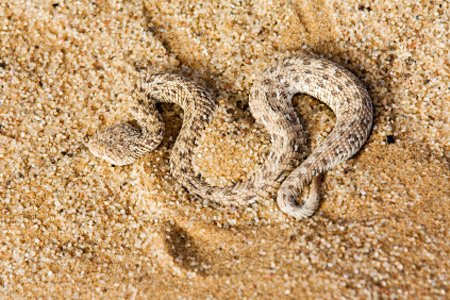While Qatar's unforgiving landscape of gravel, rocks,
and towering sand dunes give it the appearance of an
infertile wasteland, something has survived. Deep below,
protected from the blazing sun, lives a world that only
emerges after dark. This diverse land of nocturnal brutes is
what makes Qatar anything but boring. The following list
highlights five of the more interesting creatures that
inhabit the Qatari desert:
Horned Viper aka Sidewinder
This snake is the serpent to look out for whilst in Qatar.
Emerging at night to feed on small mammals and lizards, the
horned viper can be aggressive when threatened or startled.
Its bite is not poisonous, but can be very painful and its
venom can prevent a wound from clotting normally. The snake
is easily recognizable by the way it moves about sideways in
an S pattern. Luckily it is rare to see this type of snake.
Lesser Jerboa aka Kangaroo Rat
Resembling nothing more than a puff of fur with eyes, this
mighty mouse survives on fear. Emerging at night to feed on
seeds, shrubs, and insects, the lesser jerboa is a smart
coward in the face of danger. When threatened by a larger
predator, it will throw sand in the intruder's eyes before
bounding more than 1 metre (approximately 1 yard) away using
its elongated, kangaroo-like legs. That being said, it is
more than often a favourite meal of desert predators.
Nocturnal Fox aka Rüppell’s Fox
Despite being one of the lesser-seen animals of Qatar, the
nocturnal fox is a treat to those lucky enough to encounter
it. Resembling a small coyote with large, bat-like ears and
golden-brown eyes, the creature roams the dunes of
southeastern Qatar. Closely related to other fox species in
Qatar, the nocturnal fox is distinct due to its colossal
ears, which help cool the animal. Although Qatari farmers
consider it a pest, I think the animal appears majestic.
Sand Cat
Probably the coolest animal residing in Qatar is the sand
cat. It lives in sand caves, only to emerge in the evening
to hunt for rodents, reptiles, and insects. The sand cat is
specially adapted to dig deep into the sand for prey and to
survive merely on the liquids extracted from eating them.
The only time this cat congregates with other felines is
during mating season; the rest of the time it lives in
isolation. This is bad news for those of us hoping to
befriend them.
Jayaka’s Sand Boa
This dark serpent is one of Qatar's only non-venomous
snakes. However, despite lacking the ability to poison its
prey, it is a champion at wrestling. Waiting just below the
sand, the Jayaka's sand boa will erupt and strangle its
victim! But not to worry, this snake usually only grows to a
length of 60cm (about two feet).
Also see:

